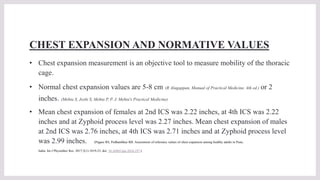Assessment of Chest Expansion.pptx
- 2. LEARNING OBJECTIVES By the end of this class, participants will be able to: 1) Define chest expansion. 2) Understand the importance of chest expansion assessment in evaluating respiratory health and identifying abnormalities. 3) Use proper positioning techniques for accurate chest expansion measurements in patients. 4) Demonstrate effective communication skills when interacting with patients during chest expansion assessment, ensuring patient comfort and cooperation. 5) Identify and address potential errors or biases in chest expansion measurements to improve reliability. 6) Record chest expansion assessment results professionally and accurately in medical records or reports.
- 3. CHEST EXPANSION AND NORMATIVE VALUES • Chest expansion measurement is an objective tool to measure mobility of the thoracic cage. • Normal chest expansion values are 5-8 cm (R Alagappan, Manual of Practical Medicine, 4th ed.) or 2 inches. (Mehta S, Joshi S, Mehta P, P. J. Mehta's Practical Medicine) • Mean chest expansion of females at 2nd ICS was 2.22 inches, at 4th ICS was 2.22 inches and at Zyphoid process level was 2.27 inches. Mean chest expansion of males at 2nd ICS was 2.76 inches, at 4th ICS was 2.71 inches and at Zyphoid process level was 2.99 inches. (Pagare RS, Pedhambkar RB. Assessment of reference values of chest expansion among healthy adults in Pune, India. Int J Physiother Res. 2017;5(1):1819-23. doi: 10.16965/ijpr.2016.197.)
- 4. IMPORTANCE OF CHEST EXPANSION MEASUREMENT IN RESPIRATORY EVALUATION The movement of thoracic rib cage is attributed to the lung expansion and the movement of the rib cage. Normal chest wall mobility is important for effective lung expansion and subsequent ventilation. Pathologic changes in the lungs or thoracic cage can restrict the thoracic movement. Reversal of disease condition by medical, surgical and physiotherapeutics can improve the thoracic expansion. Therefore measurement of thoracic expansion with an inch tape becomes a reliable objective outcome measure in patients having respiratory diseases.
- 5. Preferably, expose the chest and with the help of non-stretchable inch tape, measure the chest expansion at three levels 2nd Intercostal Space (supramammary area) 4th Intercostal Space (mammary area) Zyphoid process (inframammary area) Exhale as much as possible air then take the deepest breath possible. The difference between full expiration and full inspiration is to be recorded and documented. (Pagare RS, Pedhambkar RB. Assessment of reference values of chest expansion among he althy adults in Pune, India. Int J Physiother Res. 2017;5(1):1819-23. doi: 10.16965/ijpr.2016.197.)
- 6. HEMITHORAX MEASUREMENT • To understand whether the pathology is unilateral of bilateral, we evaluate the hemithoracic expansion of chest. • Measurements are taken from midline to midline anteriorly and posteriorly i.e. from sternum to the body of the thoracic vertebra at all the three levels.
- 7. POSSIBLE CAUSES OFALTERATIONS IN THE ASSESSMENT Generalized restriction of expansion COPD B/L lung disease Ankylosing spondylitis Interstitial lung disease Asymmetrical expansion of chest Pleural Effusion Pneumothorax Collapse Fibrosis Extensive consolidation








